
USA & CANADA (846)
Latest News
What’s taking Canada’s Armed Forces so long to tackle sexual misconduct?
Wednesday, 04 January 2023 05:23 Written by theconversation
Jason Walker, University Canada West
Sexual violence in the Canadian Armed Forces (CAF) is a common, dominant and serious issue that has severe consequences for victims — not to mention its impact on unit cohesion and morale.
Workplace violence is an ever present issue in Canadian society, impacting nearly three-quarters of Canada’s workers. Measures must be taken to treat any workplace violence as a public health issue.
But the impenetrable closed culture of the CAF in particular is prime real estate for predators and those who seek to abuse authority.
For perspective, a quarter of the women serving in the CAF say they’d reported sexual assault at least once during their military careers. The true extent is likely under-reported given a recent study that indicates 80 per cent of sexual assaults go unreported.
Canada set aside close to $800 million in 2019 to settle class-action lawsuits by current and former military members involving sexual misconduct. What’s lacking, however, is a coherent national strategy to prevent, address and reset the culture of sexualized violence within the CAF.
Anand’s first move
In November 2021, Defence Minister Anita Anand’s first act was to announce the transfer of the investigation and prosecution of sexual misconduct cases from within the Canadian Forces to the civilian justice system.
One year later, on Dec. 13, 2022, Anand stepped in front of the cameras to apologize to former and current members of the CAF for the culture of violence and to those who have survived sexual misconduct and assault. The apology was likely meant as a meaningful step towards reconciliation.
Her comment, however, that “this time is different,” raises concerns. The question becomes: “How so, and why should we believe the government this time?”

Organizational culture is often so firmly entrenched that changes in strategy have little impact. So Anand is sounding like a broken record because the CAF’s traditions, culture and much of its toxic leadership haven’t changed.
In 2015 — almost a decade ago — the CAF released an external report detailing the results of a survey on sexual misconduct in the organization conducted by Marie Deschamps, a former Supreme Court justice.
The survey found that women in the CAF endure a toxic work environment and are often the target of vulgar name-calling, sexual innuendo and jokes, harassment and assault — much of it condoned or ignored by senior military leaders. The track record of the CAF’s leadership in dealing with the issue of sexual misconduct, as well as ministerial oversight, is abysmal.
The CAF’s response
In response to the 2015 survey, the CAF implemented several initiatives aimed at addressing sexual misconduct in the organization, including creating a Sexual Misconduct Response Centre (SMRC) and appointing a Special Advisor on Sexual Misconduct.
The Special Advisor works with the CAF to identify and address the root causes of sexual misconduct and to develop and implement strategies to prevent it. Clearly this arrangement hasn’t been working.
The CAF also implemented a policy called Operation HONOUR, referred to as an enduring mission with no end date by Lt.-Gen. Mike Rouleau, with a plan to eliminate sexual misconduct in the military and support survivors. At this point, that mission has also been a failure.
Since Operation HONOUR was launched in 2015, several of Canada’s top military officers have been accused of sexual harassment.
Former top commander Jonathan Vance pleaded guilty in 2022 to criminal charges related to accusations that he committed sexual misconduct when leading the Armed Forces, despite stating that sexual misconduct was “a threat to this institution.”

In 2018, the CAF released a report on the progress made in addressing sexual misconduct in the organization.
It found that the number of reported sexual assaults had increased, in some ways a positive development because it indicated more survivors were coming forward and seeking support. The findings suggest the CAF has made some progress in increasing awareness of sexual misconduct and improving support for victims, but the organization’s culture is clearly not changing at all.
The enemy is in the same uniform
So now what?
As someone who specializes in workplace violence, it occurred to me that if I were a parent of a child who was contemplating a career in the CAF, I would need to have a difficult conversation about the likelihood of sexual assault.
Sit with that for a minute. When we think about the CAF, we acknowledge the duty, honour and courage of most of those who serve. However, the clear and present danger is not just in distant battlefields — but also from those serving in the same uniform as you.
The likelihood of adverse mental health outcomes — including anxiety, depression and PTSD — may not just come from what is experienced in battle but what is inflicted by a brother or sister in arms, severely impacting the trust, credibility and honour of the CAF.
The CAF has created a restricted culture with a leadership team lacking in diversity, inclusion and the considerations of equity. These leaders have learned from others who have perpetrated sexual misconduct.
Prevention, intervention and post-intervention measures for dealing with sexualized violence in the CAF are not considered mission-critical by the organization — but they need to be.
So is this time different? Is genuine culture change truly on the near horizon at the CAF? I hope so, but unfortunately hope is not a strategy.![]()
Jason Walker, Associate Professor, Graduate Studies, Leadership & People Management, University Canada West
This article is republished from The Conversation under a Creative Commons license. Read the original article.
Legalizing cannabis led to increased cannabis poisonings in Canadian children. It could get a whole lot worse.
Tuesday, 03 January 2023 13:48 Written by theconversation
Daniel Myran, L’Université d’Ottawa/University of Ottawa and Yaron Finkelstein, University of Toronto
When Canada legalized non-medical cannabis four years ago, there was enormous uncertainty about how legalization could impact the health of Canadians. Since then, there has been increasing evidence that legalization has resulted in some negative health effects. The clearest of these is a large increase in accidental cannabis poisonings in young children.
We conducted two large studies that found a nine-fold increase in emergency department visits and a six-fold increase in hospitalizations for cannabis poisoning in children younger than 10 years (average age of 3.5 years) following cannabis legalization in Canada. These increases have been so substantial that cannabis is now a leading cause of hospitalizations for poisoning in this age group.
The government of Canada has just launched a mandated federal review of the health and social impacts of cannabis legalization. We argue that addressing the impacts of legalization on the health of Canadians must take precedence over the financial concerns of the cannabis industry, which are demonstrated by their growing calls to roll back or remove government regulations in the upcoming review.
Provincial variation
Looking at the provincial variation in the ways that legalization was implemented across Canada, it’s clear that increases in cannabis poisonings in young children did not need to occur.
At the start of legalization in October 2018, the federal government only allowed the sale of dried cannabis flower. After an intentional one-year delay, new products, including cannabis edibles like candies and chocolates, were permitted.
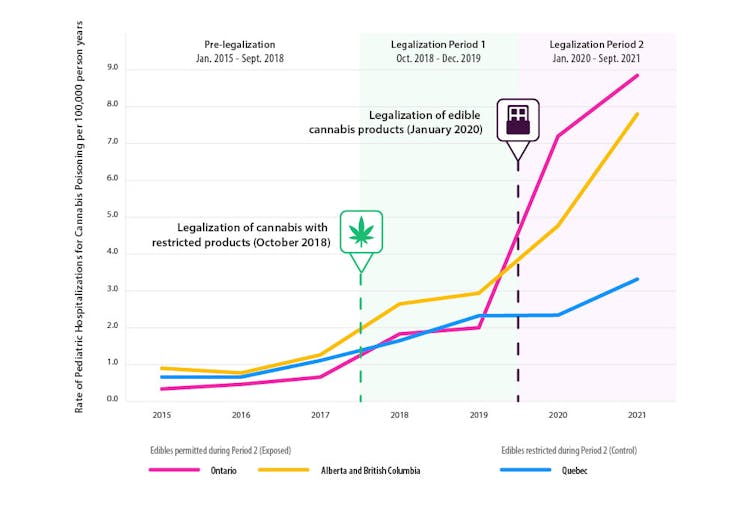
A wide variety of these edibles went on sale everywhere in Canada except in Québec, which prohibited anything in the form of chocolates, gummies and candies based on concern over their high appeal to children.
We found that most of the increase in cannabis poisonings in young kids happened after edible products came to market, and that Québec — which prohibited their sale — was protected from this effect and saw a much more modest increase in pediatric cannabis poisonings.
This lack of increase in Québec strongly argues against alternative explanations, including that these hospital visits are from illegal cannabis products, caregivers becoming more comfortable disclosing that kids may have ingested cannabis or pandemic influences.
Child cannabis poisonings
When we care for infants and young children who have been rushed to the hospital for cannabis poisoning, we see many parents and caregivers who are shocked by the severity of the cannabis effects on their intoxicated child. Children can become very sick, be less responsive and in severe cases suffer from seizures, trouble breathing on their own, or even enter a coma.
With no effective antidote, children with severe cannabis poisoning require hospitalization — sometimes in intensive care units requiring a breathing machine — until the cannabis is processed and cleared from their body. The long-term effects of these unintentional poisonings are unknown.
These increases in child poisonings occurred despite safety efforts by the federal government, which included parental education, restricting cannabis advertising, mandating plain and child-resistant packaging and restricting the amount of THC (the main psychoactive ingredient in cannabis) in a package to a maximum of 10 milligrams.
It’s important to note the cannabis industry is specifically asking that many of these regulations — including THC limits and child-resistant packaging — be removed to make their products more competitive with the illicit market.

But legalization is not shaping up to be just about replacing the illegal market. The legal market is expanding far faster than the illegal market contracts. Canadian households now spend an estimated 37.3 per cent more on cannabis from all sources (medical, legal non-medical and illegal) than they did before legalization (1.44 billion in the third quarter of 2018 vs 1.93 billion in the second quarter of 2022). That means that we, as a country, are likely using increasing quantities of cannabis.
Youth cannabis use and harms
A key goal of legalization was to reduce cannabis use and related harms in youth. While the data is less definitive, there is also some reason for concern that these harms have increased.
In Ontario, emergency department visits due to cannabis-induced episodes of severe vomiting (hyperemesis) and for cannabis addiction, cannabis-induced psychosis and poisoning have also increased in young adults since legalization.
The largest increases in emergency department visits due to cannabis occurred when the legal market began carrying new high-potency products and the number of cannabis retail stores rapidly expanded. These increases overlapped with much of the COVID-19 pandemic so it is hard to disentangle whether they reflect changes from legalization, a response to COVID-19 related stressors or a combination.
Social benefits of legalization
Increases in cannabis harms in young children and youth do not negate the social benefits of cannabis policy reform. Criminalization of cannabis created major problems, including life-altering limits on employment, education and financial opportunities. These effects were well documented to be heavily discriminatory due to over-policing among racialized communities and Indigenous youth.
Reducing criminal justice harms is of considerable public health interest. However, we argue that it does not necessitate cannabis commercialization that includes cannabis marketing, widespread cannabis retail stores and permitting ultra-high-potency products that appeal to youth and children.
As the federal government reviews the impacts of legalization to date, we recommend protecting the health of Canadian children and youth by — at a minimum — maintaining existing regulations. This includes plain and child-resistant packaging and THC content limits on edibles. Without these, we will almost certainly see greater numbers and far more severe cannabis poisonings in children.
While we examine more evidence on the impacts of legalization on younger Canadians, we also caution against loosening current rules that limit cannabis marketing and advertising which can appeal to youth and young adults.
If we want to reduce cannabis poisonings in children, we should consider further national restrictions on the taste and visual appearance of edibles and the type of edibles approved, as Québec has implemented.![]()
Daniel Myran, Public Health Physician and Canadian Institutes of Health Research Fellow, L’Université d’Ottawa/University of Ottawa and Yaron Finkelstein, Professor of Pediatrics, Pharmacology and Toxicology, University of Toronto
This article is republished from The Conversation under a Creative Commons license. Read the original article.
On World AIDS Day, Canada must lead the way in combating HIV-AIDS
Tuesday, 03 January 2023 13:43 Written by theconversation 
Julio Montaner, University of British Columbia and Viviane Dias Lima, University of British Columbia
Dec. 1 marks World AIDS Day. As researchers focused on fighting the HIV-AIDS epidemic, we are increasingly concerned all the progress made in the fight against the virus is at risk.
In 1996, the first remarkable breakthrough against the HIV-AIDS epidemic came with the novel combination of drugs that became known as Highly Active Antiretroviral Therapy (HAART).
For the first time, HAART was able to stop viral replication and render the virus undetectable in blood and bodily fluids, and consequently promote immune reconstitution. This in turn would prevent an HIV infection from developing into AIDS, significantly reducing premature deaths.
Treatment as prevention
The next major breakthrough came in the early 2000s. Through close monitoring of the epidemic in British Columbia, our research documented that HIV infected individuals who have consistent viral suppression with HAART are virtually unable to transmit the infection. This led us to recommend initiating HAART immediately following HIV diagnosis to accelerate overall HIV/AIDS control.
We called the strategy Treatment as Prevention (TasP) to illustrate the fact that HAART simultaneously stops progression to AIDS, premature death and HIV transmission.
TasP was enthusiastically embraced by the Joint United Nations (UN) Programme on HIV/AIDS (UNAIDS), in 2010. However, it soon became apparent that the TasP strategy was too ill defined, and this open the door for it to be inconsistently deployed between regions.
In 2014, UNAIDS unveiled two sequential TasP-inspired targets to quantify the proportion of people living with HIV who need to be diagnosed, the proportion of diagnosed people who need to be on HAART, and the proportion of people on HAART who need to be virologically suppressed by 2020 and 2025. Viral suppression is defined by having less than 200 copies of HIV per milliliter of blood.
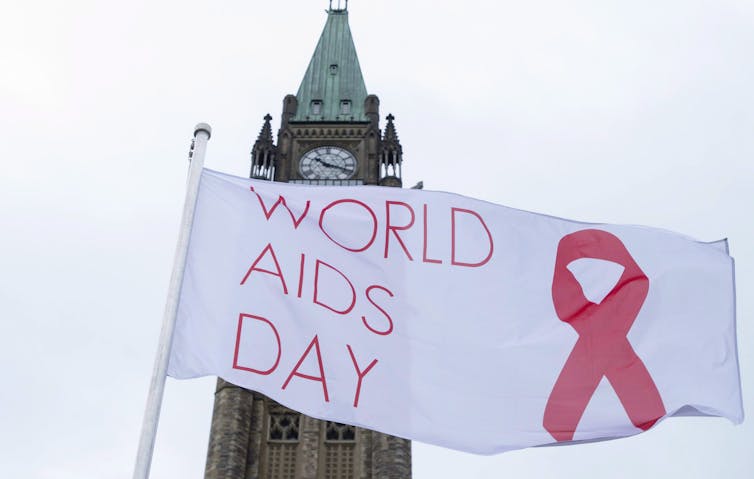
These targets were specifically designed so that by 2030 the world would see a 90 per cent decrease in AIDS mortality and new HIV infections, and meet the goal of ending the HIV-AIDS pandemic. In 2015, the UN formally endorsed the 90-90-90 by 2020 target. It endorsed our subsequent 95-95-95 by 2025 target in 2021.
However, a lack of leadership and resources have hampered progress towards the UN targets around the world. This has been exacerbated by the COVID-19 pandemic, which disrupted some medical services, decreased HIV testing, interrupted the provision of HAART and diverted funding.
Differing success rates across Canada
In 2020, the Public Health Agency of Canada (PHAC) released a much-awaited epidemiological HIV/AIDS update. The update came ahead of the International AIDS Conference held in Montréal in July 2022.
Unfortunately, the results were rather concerning. HIV cases in Canada have remained flat since the 1990s, but there is a marked contrast between British Columbia and the rest of the country. While B.C. saw a steady decline in cases between 1996 and 2020, the rest of Canada saw no further reduction in cases over the same period.
HIV cases peaked throughout Canada in the early 80s. But a decrease in high-risk sexual practices led to a substantial reduction in cases. After that, the course of the epidemics diverged.
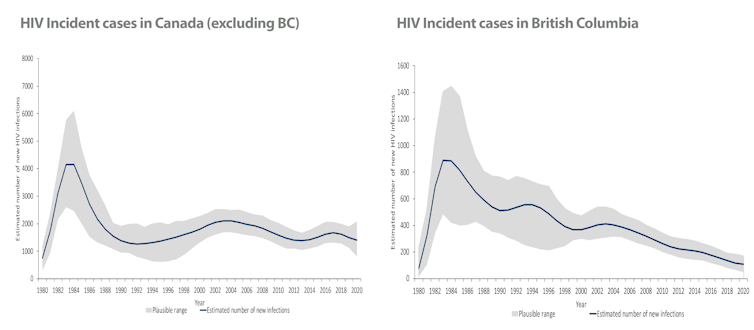
The reason for this discrepancy can be explained by the success of TasP in B.C., where the strategy originated. The graph below compares progress toward the UN’s 2020 target across Canada’s provinces and territories.
B.C., Nova Scotia, Newfoundland and Labrador and the three territories are the only Canadian jurisdictions that surpassed all three components of the benchmark target.
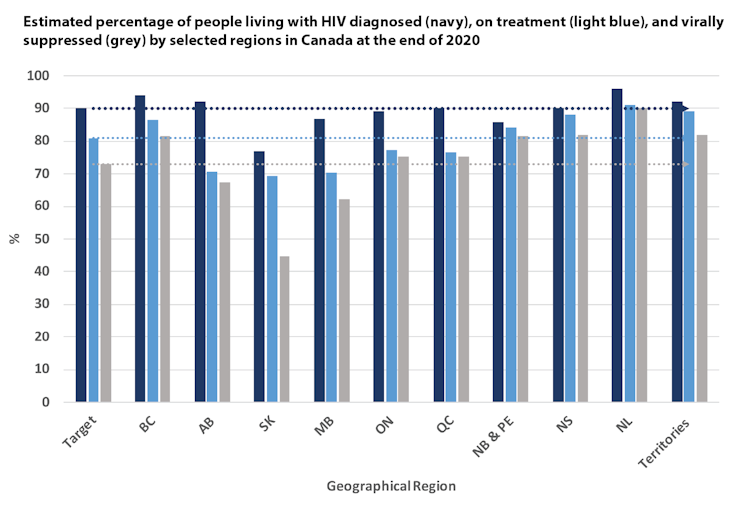
A failure to optimally implement TasP nationally has led to markedly different HIV rates across the country. In 2020, the national HIV incidence rate was 4.8 per 100,000 people. B.C., which had the highest domestic incidence rate at the peak of the epidemic in the 1980s, was well below the national average, at 2.5 per 100,000 population. The province is now at the low end of the national spectrum, together with the territories and Atlantic provinces at 2.1 and 2.2 per 100,000 population, respectively.
Alberta and Ontario were within the range of the national average at 4.2 and 4.1 per 100,000 population. At the other end, Saskatchewan, Manitoba and Québec were above the national average at 23.0, 7.7 and 5.8 per 100,000 population, respectively.
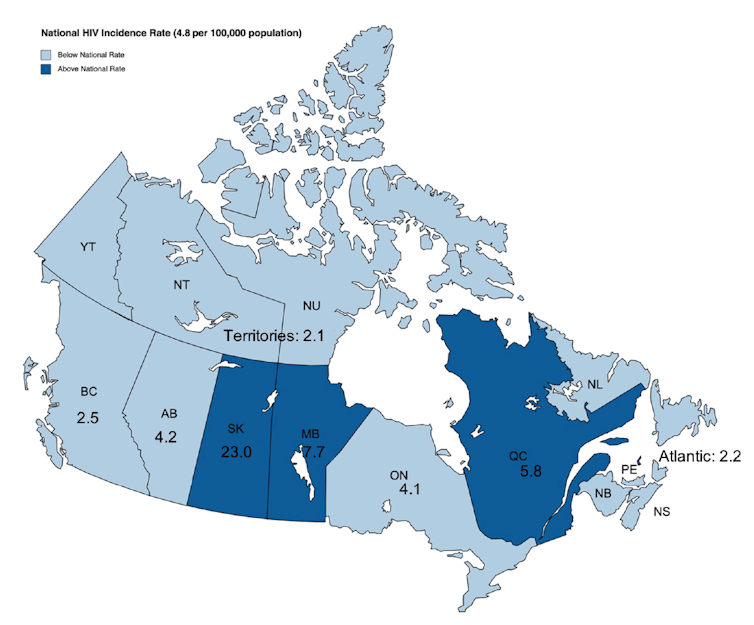
What Canada needs to do
Clearly, Canada has the tools and the means to end the epidemic. The question remains, are we up to the task? The key requirements are well known:
- Normalize HIV testing to ensure everybody knows their HIV status.
- Remove barriers to accessing health services.
- Expand support for affected populations, with particular emphasis on harder-to-reach and most affected populations (men who have sex with men, people dealing with substance use, sex workers, inmates, immigrants and First Nations Peoples).
- Make free harm reduction services widely available (condoms, lubricants, injection and smoking paraphernalia, supervised injection and smoking consumption sites and safer drug supply programs).
- Free HAART for all HIV-positive people.
- Free pre-exposure prophylaxis (PrEP) to all people at heightened HIV risk.
- Free relevant laboratory monitoring for all those on HAART or PrEP.
In addition, we must demand full transparency and accountability from our health-care system. That starts with PHAC annually reporting progress towards the UN 95-95-95 by 2025 target, HIV prevalence and AIDS-related mortality.
Finally, the federal government should sponsor a yearly independent summit of all relevant stakeholders to promote accountability and transparency, compare regional progress and share lessons learned in the process.
As a leader in treatment and prevention, Canada has a global responsibility to optimally implement a strategy to effectively combat HIV-AIDS. That will require a major commitment from the provinces given that health care is a provincial responsibility.
Canada knows how to end the HIV-AIDS epidemic. It is high time to get it done.![]()
Julio Montaner, Killam Professor, Department of Medicine, University of British Columbia and Viviane Dias Lima, Scientist, Senior Methodologist & Associate Professor, Department of Medicine, University of British Columbia
This article is republished from The Conversation under a Creative Commons license. Read the original article.
5 steps for tackling Canada’s long-term care crisis: It starts with valuing the well-being of workers
Tuesday, 03 January 2023 13:33 Written by theconversation
Sophy Chan-Nguyen, Queen's University, Ontario and Colleen Grady, Queen's University, Ontario
Canada’s long-term care sector was hard hit by the COVID-19 pandemic. Rapidly climbing patient deaths, a lack of safety provisions coupled with already-precarious employment and difficult working conditions took its toll on the mental health of health-care workers.
Yet, wellness in the long-term care sector is rarely discussed. Distress due to difficult working conditions is often dismissed as a part of the job description. Workers are expected to “suck it up” and manage their own emotions on their own time.
The sector is currently being held together by a very vulnerable workforce and it is situated to fail without immediate intervention.
Support for self-care and protection from moral distress
In our research, we examined the impacts of two critical psychological safety factors on the long-term care workforce amidst the COVID-19 pandemic — support for self-care and protection from moral distress. Health-care workers expressed the increased need for resources to support their well-being and to address longstanding workforce issues. Five recommendations for a stronger long-term care sector are proposed.
1. Address long-standing structural issues
Structural issues have been brought to light during the COVID-19 pandemic. This includes issues that are economic, social and organizational in nature.
While the COVID-19 pandemic exacerbated the challenges facing the long-term care sector, workers stated that these issues are not new. Rather, decades of neglect and lack of funding has made low pay and unsafe working conditions acceptable.

The pandemic intensified existing problems with staffing shortages. In 2020, long-term care staff members made up more than 10 per cent of Canada’s total COVID-19 infection cases. Further, restricting informal caregivers from entering homes contributed to increased workloads.
Institutional support for any sort of resource (mental health, personal protective equipment (PPE), staffing) was stretched thin to keep care homes running. Resource limitations kept the hands of management teams tied, suggesting that distress was endemic across the sector.
2. Continuing education and training for self-care
Supporting staff through continuing education and training can increase their capacity for psychological self-care and help protect them from moral distress.
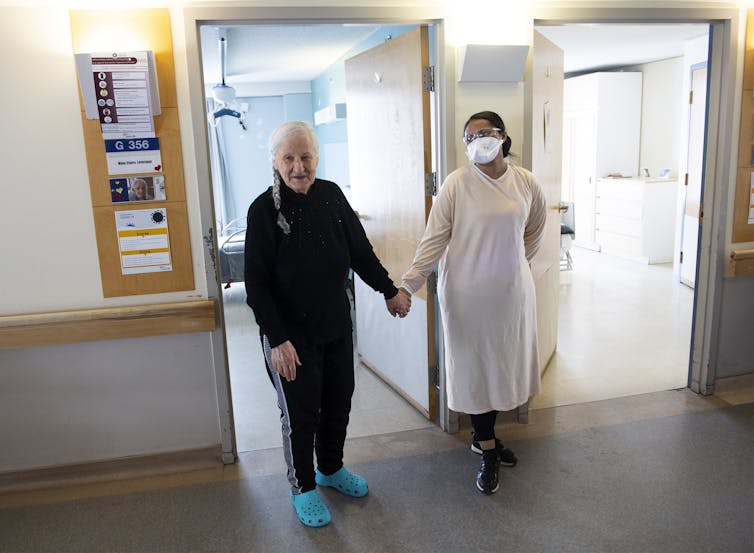
Continuing education and training can significantly improve psychological well-being among long-term care workers. Communication-focused training approaches have resulted in improvements in staff turnover, depression and anxiety. Self-compassion and acceptance-based approaches found a significant reduction in mental health symptoms.
Educational sessions connect staff with other staff, allowing them to share their expertise and frustrations — helping to alleviate conflicts and tensions amongst teams. Virtual forums can be used for peer-to-peer learning, community building and moral support.
Training must be made available to all staff. Our study found that unregulated staff such as personal support workers were often not invited to take part in training programs or company resources.
3. Invest in leadership development
Improved leadership can foster improved team functioning.
Bullying and gossip is particularly rampant in the long-term care workplace. Workers expect one another to work through distress and asking for a day off can be seen as a weakness and increasing the workload for others.
Supportive managers are critical to the psychological well-being of staff. A study on transformative leadership found a reciprocal relationship between leadership, self-reported staff well-being, team efficacy and self-efficacy — leading to job satisfaction and well-being. Transformative leaders encourage employees to create change inwardly by connecting professional goals to a wider sense of belonging in their workplace.
Underfunding and resource constraints make it difficult to provide meaningful and accessible supports, reducing workers’ ability to protect themselves against moral distress in the workplace.
4. Ensure safe working conditions

Insufficient personal protection equipment (PPE) at the workplace was a concern for workers in the sector. Staff shortages and lack of knowledge from management contribute to poor infection control and safety. Low wages and limited benefits also place workers in vulnerable situations, with limited options to practice physical and psychological self-care.
Funnelling resources and funding into this sector will not only improve staffing. It is critical for reducing the rapid turnover caused by uncontrolled exposure to COVID-19.
5. Supportive human resource policies
Long-term care needs to develop and/or improve human resource policies that support workers and acknowledge their value.
Low wages and precarious employment characterize this sector. Workers were fearful to take time off to get the COVID-19 vaccine for fear of losing wages.
Part-time and contract workers in the sector, often personal support workers, are not eligible for medical benefits and must pay out-of-pocket for injuries incurred at work. Many of these workers are racialized, immigrant women. Workers also often do not have entitlement to paid sick days. These factors point to systemic discrimination and undervaluing compared to other professionals in the sector.
A call to action
The Royal Society of Canada argues that the very first step to tackling the long-term care crisis is through workforce reform and redesign. This not only addresses low wages and resource shortages but serves more importantly to rebuild trust and dignity. To bolster support for the sector, public awareness and advocacy play a key role in advancing health-care reform.![]()
Sophy Chan-Nguyen, Research Associate, Queen's University, Ontario and Colleen Grady, Associate Professor, Family Medicine, Queen's University, Ontario
This article is republished from The Conversation under a Creative Commons license. Read the original article.
Popular News
How the Canada Border Services Agency tolerates and even encourages refugee mistreatment
Sunday, 01 January 2023 14:43 Written by theconversation 
Kathryn Tomko Dennler, York University, Canada and Brianna Garneau, York University, Canada
Refugee advocates have long known about systemic problems with immigration enforcement in Canada, resulting in wrongful detentions and deportations, as well as people being tortured upon return to their countries of origin.
Our new research explains why these problems exist.
Flaws in Canada Border Services Agency’s (CBSA) structure and mandate mean that misconduct is tolerated and even incentivized. Independent oversight of CBSA and legislative changes are needed to protect refugee rights.
Deportation affects refugee rights
Our findings show that more than half the people deported from Canada each year made refugee claims. While some people are ready to return home, others still fear persecution.
Decisions on a refugee claim can be wrong. Outcomes of refugee claims depend on the Immigration and Refugee Board member who hears the claim, the quality of legal representation and subjective credibility determinations made by those hearing claims.
People who are at risk of persecution, torture or worse can be denied refugee status and face imminent deportation. For these reasons, deportation is closely linked to refugee rights.

How someone is treated during the deportation process matters. CBSA places an emphasis on “timely removals” at the expense of respecting rights. And although Canada prides itself on its safeguards, they are insufficient.
For example, people can apply for a pre-removal risk assessment to demonstrate the risk they face prior to being deported. The risk assessment was created to meet Canada’s obligations to protect people from persecution.
But in 2012, the government introduced legislation that limits access to the pre-removal risk assessment. Since then, people can only apply for it if they remain in Canada for at least a year after their refugee claim was refused.
Our research found that whether someone is deported before the end of that year comes down to chance, defeating the very purpose of the risk assessment.
CBSA not equipped for sensitive work
Deportation is sensitive work. Yet the CBSA lacks the structure and management controls to carry out activities with human rights implications.
We obtained job descriptions for senior leaders in CBSA who oversee enforcement. They do not mention human rights treaties or obligations. There is no evidence that performance measures for leaders, front-line staff or the agency as a whole include compliance with international human rights obligations.

Instead, CBSA documents emphasize the need for timely removals, specifically enforcing a deportation within one year of a refused refugee claim. Such fast deportations, as mentioned, may not leave refugee claimants with enough time to apply for the risk assessment.
Legal representatives we interviewed reported many instances of misconduct by CBSA officials, such as lying, abuse of power, concocting documents and baseless detentions to enforce a deportation. These tactics advance, rather than violate, CBSA’s mandate in the absence of requiring its employees to honour human rights obligations.
The CBSA also lacks an independent oversight body to review its work, investigate complaints and make binding recommendations. That means complaints about the conduct of CBSA officers must be made to CBSA.
A complaint can work against the person being deported. Many refugee lawyers told us they don’t bother reporting misconduct.
Lydia, a refugee lawyer, told us:
“I’ve complained about CBSA officers over the years with absolutely no effect. In fact, several officers who lied under oath were promoted after they had engaged in really disreputable conduct. Why waste your time?”
Legal help beyond reach
The deportation process is complex and unpredictable. Delaying or preventing a deportation requires expert legal advice. But it’s not easy to get legal representation for deportation cases, especially on a tight timeline.
Deportation cases require intense effort over a short period of time. Many experienced refugee lawyers rarely take a deportation case unless it’s a pre-existing client.
While refugees in Ontario may be eligible for legal aid, it doesn’t cover the real number of hours it takes to vigorously pursue the case. Sathya, a refugee lawyer, told us:
“It’s literally the worst work in this field …. It wipes every single thing off your desk. You have to put aside everything, cancel all your evening plans because you’re going to be pulling all-nighters. It is very, very difficult.”
What’s more, legal fees for deportation cases are often thousands of dollars, which is unaffordable for many refugee claimants.
Addressing injustice in deportations
An agency that conducts deportations must respect human rights obligations and the Canadian Charter of Rights and Freedoms. CBSA job descriptions should be revised to require compliance, which should be measured in performance evaluations.
To further address bias, CBSA needs to institute an anti-racism strategy, like the Anti-racism Strategy 2.0 being implemented within Immigration, Refugees, and Citizenship Canada.
The Canadian government should repeal the one-year bar on a refugee claimant seeking a pre-removal risk assessment to ensure that people at risk of persecution are not deported.
Finally, given the life-or-death implications of their work, the CBSA needs independent oversight. The Liberal government has proposed a bill to introduce such a watchdog. That bill must be passed to ensure respect for refugee rights.![]()
Kathryn Tomko Dennler, Immigration Researcher, York University, Canada and Brianna Garneau, PhD Candidate, Socio-legal Studies, York University, Canada
This article is republished from The Conversation under a Creative Commons license. Read the original article.
Immigrants could be the solution to Canada’s labour shortage, but they need to be supported
Sunday, 01 January 2023 14:36 Written by theconversation
Rupa Banerjee, Toronto Metropolitan University
Immigration is largely accepted as one of the best strategic responses to Canada’s declining birth rates, aging population and labour market shortages. In many ways, immigrants are now positioned to be the saviours of Canada’s post-pandemic recovery.
Even with steadily rising numbers and the challenges brought on by the COVID-19 pandemic, Canadians are more favourable towards immigration than ever before.
Canada’s new immigration targets are unprecedented — more than 1.4 million new permanent residents will be admitted by 2025. Setting targets, however, is the easy part. More difficult is ensuring Canada is up to the task of selecting and welcoming the influx of newcomers that will be arriving over the next few years.
But if immigrants are going to be a panacea for our demographic and economic challenges, they must be able to find skills-appropriate employment and settle into communities. Selecting the right mix of newcomers is the first crucial element to consider.
Barriers for immigrant workers
Employers across Canada have reported labour shortages in a range of skill levels and sectors, including accommodation, food services, skilled trades and health care.
The current economic immigrant selection system, Express Entry, prioritizes “high-skilled” immigrants — those with post-secondary education — in fields like information technology and finance. However, many of these individuals face significant underemployment, with foreign credentials discounted and the requirement to have Canadian experience preventing many from finding skills-appropriate work.
The new immigration plan will expand the eligible skill levels and ease access to permanent resident status for essential workers who were previously excluded from the selection system, like transport truck drivers, nurse assistants and heavy equipment operators.
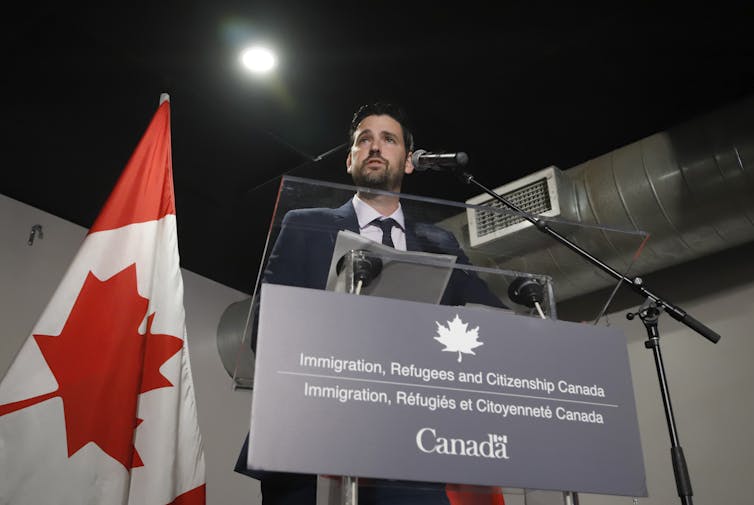
Although this is a positive development, it is an open question whether so-called “lower-skilled” newcomers — those without post-secondary education — will find work and stay in their intended occupations. Canada’s focus on high-skilled immigration thus far has been based on research that shows that higher-skilled newcomers have better labour market outcomes in the long term than those with lower skills.
In general, less educated workers tend to be more susceptible to unemployment and poverty.
However, given the rampant devaluation of foreign credentials and the oversupply of high-skilled workers, it is possible that lower-skilled immigrants in essential sectors will actually face less relative labour market disparity than their high-skilled counterparts.
Changes to Express Entry
Another significant change is the introduction of targeted invitations within Express Entry. Currently, Express Entry applicants are evaluated by a comprehensive ranking system. Candidates that meet a certain cutoff score are invited to apply in biweekly draws.
Applicants know their chance of being invited based on their ranking system score. However, with targeted invitations, it will be up to Immigration, Refugees and Citizenship Canada to determine which characteristics are valued in each draw. This adds significant uncertainty for applicants who may be overlooked even with a high ranking system score.
Government officials have stated that targeted draws will allow for the prioritization of high demand occupations. While occupation-specific admission has the advantage of potentially addressing talent shortages in certain fields, it may also result in an oversupply of workers in some areas.
If labour demand shifts due to economic downturn, these workers may be left out in the cold, as was the case for tech workers after the dot-com bubble burst in the early 2000s.
Investing in supports
For the immigration plan to be successful, the selection system is just one side of the equation. The government must also invest in the infrastructure needed to accommodate the population growth, including affordable housing, access to health care and schooling supports.

Labour market integration policies and practices are equally important to ensure that immigrants’ skills are recognized and properly utilized. For example, immigrants trained in regulated occupations, like nursing, struggle to enter their professions, even though many of these fields have severe labour shortages.
Although several provinces now have fairness commissioners whose mandate is to enhance transparency in occupational licensing processes, significant barriers remain.
The experience is not much better for immigrants seeking employment in unregulated fields. Currently, the burden of integration is placed disproportionately on individual immigrants themselves. However, all stakeholders — including policymakers, occupational regulatory bodies, educational institutions and employers — should play a role in this process.
Everyone has a role to play
Settlement services and occupationally relevant language training must be made more accessible for newcomers with lower levels of education, since official language fluency is among the most important determinants of success and lower-skilled immigrants tend to be less fluent.
It is also more crucial than ever before to implement active labour market policies (ALMPs) that prioritize upskilling, reskilling and on-the-job training for essential workers.
Lastly, employer engagement is vital. Although Canadian employers demand more immigration, they tend not to hire permanent immigrants into high quality positions. Instead, they often prefer to recruit temporary foreign workers into low wage, precarious roles.
This is short sighted, particularly in a labour shortage, since decent working conditions and fair treatment improve productivity and competitiveness. Employers should work with immigrant-serving organizations, like the Toronto Region Immigrant Employment Council, to better understand foreign qualifications and experience so they can leverage the skills of immigrant workers more effectively.
Finally, it is important for managers and other decision-makers to recognize unconscious bias and improve their own intercultural competence. Without the active participation of employers, even the most enlightened selection policies will fall flat. Canadians currently have a positive view of immigration, and we are seen as a global leader, but there is no guarantee that this will remain if immigrant integration isn’t adequately supported.![]()
Rupa Banerjee, Canada Research Chair and Associate Professor of Human Resource Management and Organizational Behaviour, Toronto Metropolitan University
This article is republished from The Conversation under a Creative Commons license. Read the original article.
Most Canadians welcome immigrants, but anti-immigration sentiments persist
Sunday, 01 January 2023 14:31 Written by theconversation 
Constantin Colonescu, MacEwan University and Andrea Wagner, MacEwan University
Hostility towards immigrants has become a powerful component of right-wing populism in several western countries. But for the time being, Canada has not succumbed to this wave.
In Canada, attitudes towards immigration have never been a particularly divisive or salient election issue. Maxime Bernier’s People’s Party of Canada is the only federal party whose platform includes radical reform of Canada’s immigration system. Nonetheless, the party has twice failed to gain any seats in parliament.
Reinforcing the idea that multiculturalism lies at the centre of Canadian identity, a recent Focus Canada report finds that the public “has never been more supportive” of immigrants.
Our ongoing research into anti-immigration attitudes is primarily motivated by recent xenophobic attacks which expose a resurgence in anti-immigrant feelings. For instance, the 2021 London, Ont. hit-and-run, described by the prime minister as a “terrorist attack,” which killed four members of a Muslim family, shocked many Canadians. A man facing terror-related murder charges is scheduled to stand trial in September 2023.
In 2020, Canadian police reported 2,669 criminal acts motivated by hatred —the largest number recorded since 2009.
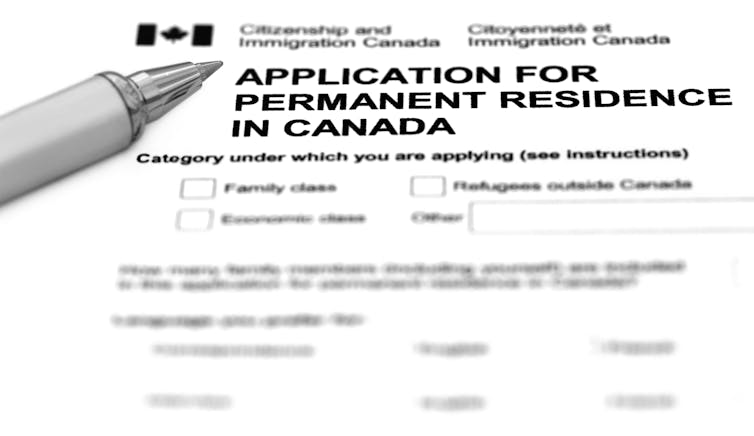
Anti-immigrant sentiments exist, but no province stands out
We conducted a survey in September 2022 with Canadian polling firm Abacus Data on a sample of 1,000 respondents across Canada. We asked four questions:
1) Whether immigration hurts the economy.
2) Whether the number of immigrants should be reduced.
3) Whether immigrants increase crime.
4) Whether cultural diversity limits opportunities for Canadians. By “opportunities,” we mean in areas such as jobs, education and housing.
Previous studies revealed that some provinces were less welcoming to immigrants than others. In 2019, pollsters EKOS politics found that 40 per cent of Canadians were apprehensive about “visible minority” immigrants.
EKOS reported that 56 per cent of Albertans, 46 per cent of Ontarians and 31 per cent of British Columbians echoed this sentiment. Only residents of Atlantic Canada were more immigrant friendly. Similarly, a 2021 report by Maru Public Opinion found that only half of Canadians believed that Alberta was a welcoming place for immigrants.
However, we found no significant differences across Canadian provinces in anti-immigrant sentiments. Furthermore, our research suggests that the majority of respondents do not hold strong anti-immigrant views.
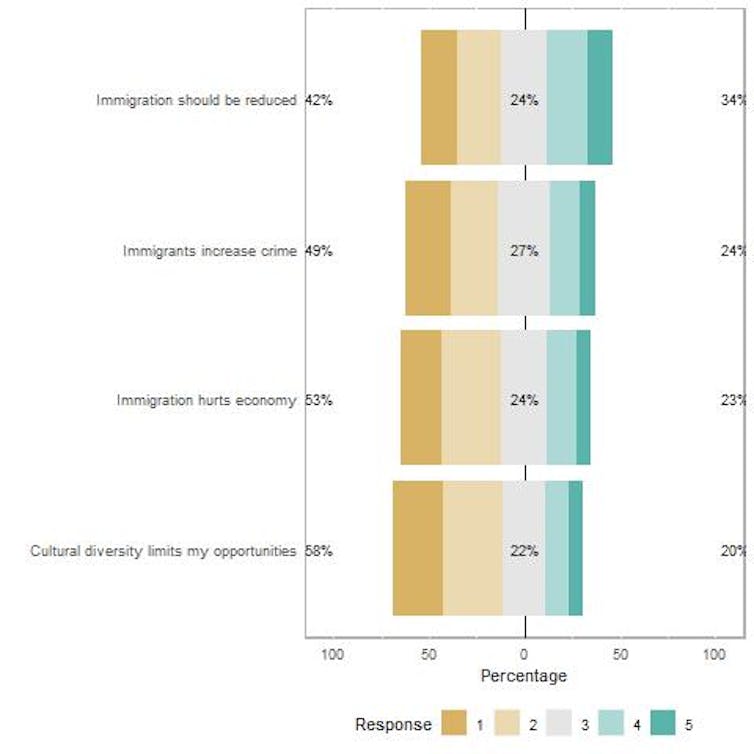
When asked whether “immigration hurts the economy,” 53 per cent disagreed. While Canadians do not reveal strong anti-immigrant sentiments, they are less immigrant-friendly than we expected. We found that 24 per cent of the respondents do not have an opinion on immigration, while 23 per cent agree that immigration hurts the economy.
Moreover, 34 per cent of Canadians agreed that “immigration should be reduced.” Twenty-four per cent agree that “immigrants increase crime” and 20 per cent agree that “cultural diversity limits their opportunities.”
Attitudes within the immigrant population
Our study shows that recent immigrants to Canada are more tolerant to immigration than those who immigrated in the distant past, but the differences are rather small. Other researchers have arrived at a similar conclusion when examining immigrants’ attitudes toward immigration.
Those who have acquired citizenship in their host countries tend to be more skeptical about immigration than newer non-citizen immigrants. There could be several hypotheses that explain this trend, however, more research is needed to shed light on why that might be.
Anti-immigrant attitudes stronger among convoy supporters
Prime Minister Justin Trudeau described the truckers’ protest in Ottawa in early 2022 as imbued with “symbols of hatred and division” and accused protesters of “abuse and racism.” In contrast, the convoy was endorsed by prominent American right-wing figures including Donald Trump and Fox News commentators.
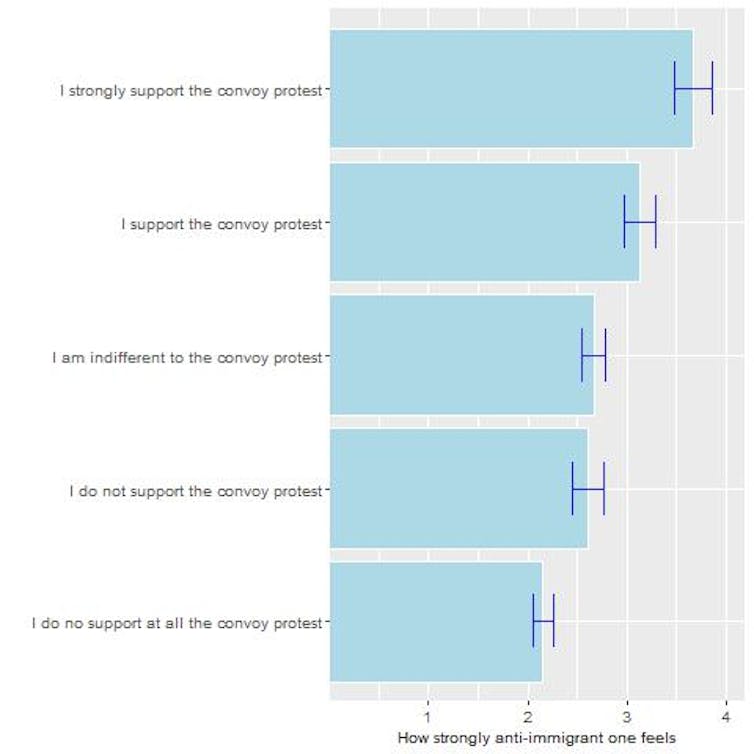
We found that stronger support for the convoy movement is associated with stronger anti-immigrant feelings. This finding lends some credence to Trudeau’s sentiment that racism and xenophobia were present among the convoy protesters.
We found that moderate anti-immigrant sentiments exist in Canada, but without noticeable differences between provinces. The trucker Convoy protest supporters showcased stronger anti-immigrant attitudes than those who opposed these protests. This might challenge Canada’s all-encompassing tradition of diversity and tolerance.![]()
Constantin Colonescu, Associate Professor of Economics, MacEwan University and Andrea Wagner, Assistant Professor, Political Science, MacEwan University
This article is republished from The Conversation under a Creative Commons license. Read the original article.
Canada delays expanding medical assistance in dying to include mental illness, but it’s still a policy built on quicksand
Sunday, 01 January 2023 14:30 Written by theconversation 
Karandeep Sonu Gaind, University of Toronto
The federal government admitted Thursday it needs more time before expanding Canada’s controversial medical assistance in dying (MAID) policy to enable MAID solely for mental illness.
Although the government had recently announced its intention to proceed with expanding MAID for those with mental health disorders by next March, Justice Minister David Lametti said he had heard from medical experts that the health-care system wasn’t prepared to deal with patients who want to end their lives for mental health reasons. He did not commit to a new deadline.
But the justice minister said Ottawa was only seeking to delay implementation of the MAID changes — it’s still clear the government remains intent on further expanding its legislation to include mentally ill people who are suicidal and could get better.
It’s one of many controversial elements of the proposed changes to the MAID legislation, and remains cause for concern.
Canada’s federal minister of disability inclusion recently expressed feeling devastated about Canadians being driven to seek assisted death through MAID — medical assistance in dying — due to lack of social supports.
Some are pushing for MAID for infants, while others think non-dying disabled people on wait lists should receive MAID. When the minister of justice suggests we should make it easier for those ambivalent about suicide to die, that is bone chilling.
When Canada embarked on this journey years ago, I cautioned about the importance of ensuring we “do the least harm” with our expanding laws. As physician chair of my hospital MAID team, I have seen the myths and realities that have fuelled our MAID expansion.
False autonomy and false compassion
As a society, we take comfort that MAID is provided for compassionate relief from suffering. Individually, MAID has been sold to Canadians as an autonomous choice, and framed as a right. When MAID was introduced in 2016, for those whose deaths were reasonably foreseeable, these principles may have been true. In contrast, our MAID expansion to non-dying disabled people has been misled by the fallacies of false autonomy and false compassion.
True autonomy requires true choice. For those of us fortunate enough to live lives with privilege, choosing “death with dignity” can be sold as an autonomous choice. Yet we have now had marginalized Canadians living in poverty be given state-supported suicide who have openly said they chose MAID not to avoid suffering from illness, but because society had failed to provide them a chance to live with dignity.

Most would be hard-pressed to argue it reflects true autonomy with a range of choices when the marginalized poor are enticed toward “painless” death to escape a painful life of poverty.
Canadians have rationalized that non-dying disabled people are being provided MAID in the name of compassion. However, it is not compassionate to provide death for one reason while pretending it is for another. We have reassured ourselves that MAID is for medical conditions that will not improve, or are irremediable. In the court cases that originally established MAID — which involved conditions like ALS and spinal stenosis — or for medical conditions like cancers, that can be true.
However, evidence shows it is impossible to predict that a mental illness will not improve in any individual. Yet expansion activists mistakenly believe they can make such predictions. Science tells us their chance of being right amounts to chance or less, with precision modelling showing only 47 per cent of “irremediability” predictions end up being correct — which is worse than flipping a coin.
False safety
Perhaps most tragically, the twin pillars of false autonomy and false compassion fuelling the expansion agenda have been propped up by the third myth of false safety.
Until now, expansion activists have reassured that “MAID is not suicide.” When provided to help avoid a painful death for those who are dying, we can distinguish MAID from suicide. Yet when expanded to those seeking death for mental illness, evidence shows MAID becomes indistinguishable from suicide. We cannot differentiate those seeking psychiatric euthanasia from suicidal individuals who resume fulfilling lives after being provided suicide prevention, rather than facilitated death.

All this sobering evidence is sadly borne out by our now common headlines of assisted suicide being provided to marginalized Canadians seeking escape from life suffering and poverty.
The government-appointed federal panel, chaired by an expansionist in favour of MAID for mental illness, was responsible for providing safeguards, standards and guidelines for how to implement MAID for mental illness. Instead, the panel recommended that no further legislative safeguards be required before providing death for mental illness, and did not provide any specific standards for the length, type or number of treatments that should be tried before providing MAID. Its report even suggested society had made an “ethical choice” that MAID should be provided even if suicide and MAID were the same.
Two members of the initial 12-member panel resigned, including the health-care ethicist and a mental health advocate panelist with lived experience.
Suicide prevention
The whole issue of suicide prevention has been shockingly absent from many of these discussions, including those with key medical associations. In all of its consultations on Bill C-7 leading up to the sunset clause, the Canadian Psychiatric Association (of which I am a former past president) inexplicably never once presented known evidence about suicide risks associated with mental illness.
While some organizations such as the Canadian Association for Suicide Prevention discussed the importance of preventing suicide, CPA never raised this crucial topic — indeed they avoided using any variant of the word “suicide.”

With this vacuum of national leadership and evidence-based guidance, perhaps it is not surprising that our minister of justice recently suggested that MAID “provides a more humane way for [people with mental illness] to make a decision” when “for physical reasons and possibly mental reasons, [they] can’t make that choice themselves to do it themselves.”
This remarkable statement, coming from the person entrusted with responsibly implementing Canada’s assisted dying laws, will keep me and many of my colleagues up at night.
The need to pause
I am not a conscientious objector. However it is clear to me that Canada’s planned expansion of MAID to mental illness is based on ignorance — if not outright disregard — of fundamental suicide prevention principles. It appears to ignore what drives the most marginalized people to consider death as an alternative to life suffering. Perhaps, though, it does not ignore the cost savings of providing MAID rather than treatment and community support for dignified living.
The Carter v. Canada and Truchon v. Canada court cases shaping MAID laws did not review or rule on MAID for mental illness. Expanding MAID within three months would have meant providing facilitated suicide for the mentally ill without any standards, or any consideration of the role of suicide prevention.
Postponing the March 2023 expansion of euthanasia for mental illness is the only responsible course. Canadians and mental health organizations recognized this and called for it, with the Canadian Association for Suicide Prevention and over 200 individual psychiatrists so far signing a petition to this effect, and the academic chairs of the departments of psychiatry across Canada joining this call for delay.
To proceed with the planned changes would have been morally, medically and politically irresponsible. Moving forward, it will be important to ensure our future policies are evidence-based. Fortunately, the situation is not yet irremediable.
If you are experiencing suicidal thoughts, you need to know you’re not alone. If your life or someone else’s is in danger, call 911 for emergency services. For support, call Canada Suicide Prevention Service (CSPS) at 1-833-456-4566. Visit Crisis Services Canada for more resources.![]()
Karandeep Sonu Gaind, Professor of Psychiatry, University of Toronto
This article is republished from The Conversation under a Creative Commons license. Read the original article.









